
common witch hazel
Hamamelis virginiana
Cycle:
Perennial
Watering:
Average
Hardiness Zone:
3 - 8
Flowers:
Flowers
Sun:
Full sun,part shade
Soil:
Sandy Loamy Clay
Fruits:
Fruits In Spring Ready In
Leaf:
Yes
Growth Rate:
Low
Maintenance:
Low
Drought Tolerant:
Yes
Care Level:
Medium
watering
Common witch hazel should be watered deeply and infrequently. Water the plant when the top of the soil is dry, usually about once a week. Make sure to water until the soil is saturated and the excess water begins to drain from the drainage holes at the bottom. You should water until you see water coming out of the drainage holes at the bottom of the pot. Doing this will ensure that the soil is moist enough and help prevent root rot.
sunlight
Common witch hazel needs an MINIMUM of 4-6 hours of sunlight per day within its growing season, which is typically between early spring and late fall. If the plant is not receiving enough sunlight, its leaves may become weak and discolored. It’s best to plant the common witch hazel in an area with partial shade to full sun, typically in the late afternoon or early evening. Too much direct sunlight during the day (especially during the hottest months of the year) may cause the leaves to become scorched or dried out.
pruning
Common witch hazel (Hamamelis virginiana) should be pruned in late winter, usually in February or March. Pruning it in late winter will remove dead wood, stimulate new growth in the spring, and increase blooms the following season. When pruning witch hazel, it is important to remove dead, diseased, and broken branches as well as branches that cross over each other. Pruning should also be used to control the shape and size of the plant. Witch hazel should be lightly pruned, as it tends to respond well only to minimal pruning. It is best to only remove 1 or 2 branches at once and to prune selectively so as to maintain the natural form and formative branches of the shrub.
